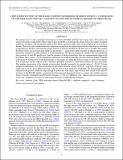| dc.contributor.author | Goddi, C. | |
| dc.contributor.author | Humphreys, E. M. L. | |
| dc.contributor.author | Greenhill, Lincoln J. | |
| dc.contributor.author | Chandler, C. J. | |
| dc.contributor.author | Matthews, Lynn D. | |
| dc.date.accessioned | 2015-02-27T16:35:19Z | |
| dc.date.available | 2015-02-27T16:35:19Z | |
| dc.date.issued | 2011-02 | |
| dc.date.submitted | 2010-06 | |
| dc.identifier.issn | 0004-637X | |
| dc.identifier.issn | 1538-4357 | |
| dc.identifier.uri | http://hdl.handle.net/1721.1/95732 | |
| dc.description.abstract | We present new λ7 mm continuum observations of Orion BN/KL with the Very Large Array. We resolve the emission from the young stellar objects radio Source I and BN at several epochs. Radio Source I is highly elongated northwest-southeast, and remarkably stable in flux density, position angle, and overall morphology over nearly a decade. This favors the extended emission component arising from an ionized edge-on disk rather than an outwardly propagating jet. We have measured the proper motions of Source I and BN for the first time at 43 GHz. We confirm that both sources are moving at high speed (12 and 26 km s–1, respectively) approximately in opposite directions, as previously inferred from measurements at lower frequencies. We discuss dynamical scenarios that can explain the large motions of both BN and Source I and the presence of disks around both. Our new measurements support the hypothesis that a close (~50 AU) dynamical interaction occurred around 500 years ago between Source I and BN as proposed by Gomez et al. From the dynamics of encounter, we argue that Source I today is likely to be a binary with a total mass on the order of 20 M ☉ and that it probably existed as a softer binary before the close encounter. This enables preservation of the original accretion disk, though truncated to its present radius of ~50 AU. N-body numerical simulations show that the dynamical interaction between a binary of 20 M ☉ total mass (Source I) and a single star of 10 M ☉ mass (BN) may lead to the ejection of both and binary hardening. The gravitational energy released in the process would be large enough to power the wide-angle, high-velocity flow traced by H2 and CO emission in the BN/KL nebula. Assuming that the proposed dynamical history is correct, the smaller mass for Source I recently estimated from SiO maser dynamics (gsim7 M ☉) by Matthews et al., suggests that non-gravitational forces (e.g., magnetic) must play an important role in the circumstellar gas dynamics. | en_US |
| dc.description.sponsorship | National Science Foundation (U.S.) (NSF AST 0507478) | en_US |
| dc.language.iso | en_US | |
| dc.publisher | Institute of Physics/American Astronomical Society | en_US |
| dc.relation.isversionof | http://dx.doi.org/10.1088/0004-637x/728/1/15 | en_US |
| dc.rights | Article is made available in accordance with the publisher's policy and may be subject to US copyright law. Please refer to the publisher's site for terms of use. | en_US |
| dc.source | American Astronomical Society | en_US |
| dc.title | A MULTI-EPOCH STUDY OF THE RADIO CONTINUUM EMISSION OF ORION SOURCE. I. CONSTRAINTS ON THE DISK EVOLUTION OF A MASSIVE YSO AND THE DYNAMICAL HISTORY OF ORION BN/KL | en_US |
| dc.type | Article | en_US |
| dc.identifier.citation | Goddi, C., E. M. L. Humphreys, L. J. Greenhill, C. J. Chandler, and L. D. Matthews. “A MULTI-EPOCH STUDY OF THE RADIO CONTINUUM EMISSION OF ORION SOURCE. I. CONSTRAINTS ON THE DISK EVOLUTION OF A MASSIVE YSO AND THE DYNAMICAL HISTORY OF ORION BN/KL.” The Astrophysical Journal 728, no. 1 (January 14, 2011): 15. © 2010 American Astronomical Society. | en_US |
| dc.contributor.department | Haystack Observatory | en_US |
| dc.contributor.mitauthor | Matthews, Lynn D. | en_US |
| dc.relation.journal | Astrophysical Journal | en_US |
| dc.eprint.version | Final published version | en_US |
| dc.type.uri | http://purl.org/eprint/type/JournalArticle | en_US |
| eprint.status | http://purl.org/eprint/status/PeerReviewed | en_US |
| dspace.orderedauthors | Goddi, C.; Humphreys, E. M. L.; Greenhill, L. J.; Chandler, C. J.; Matthews, L. D. | en_US |
| mit.license | PUBLISHER_POLICY | en_US |
| mit.metadata.status | Complete | |
